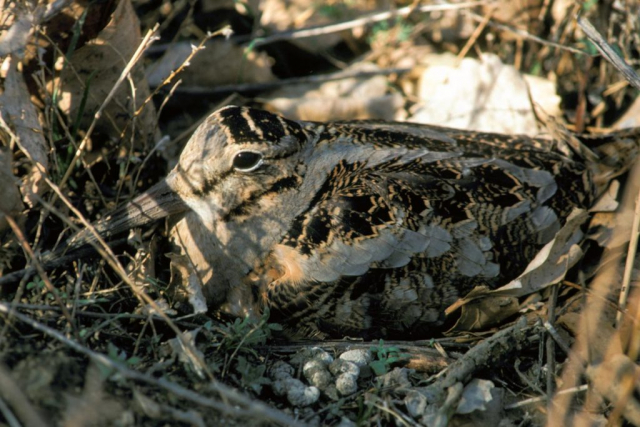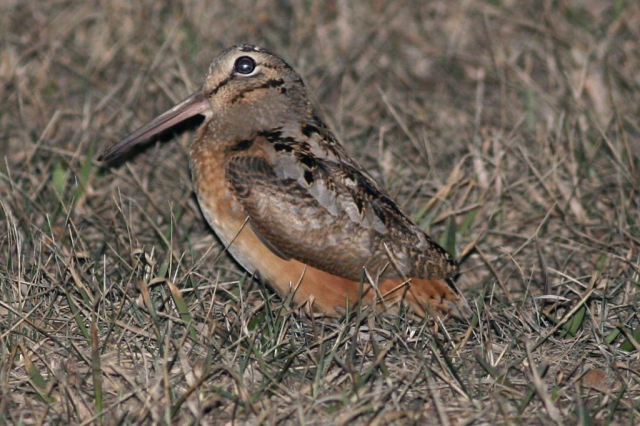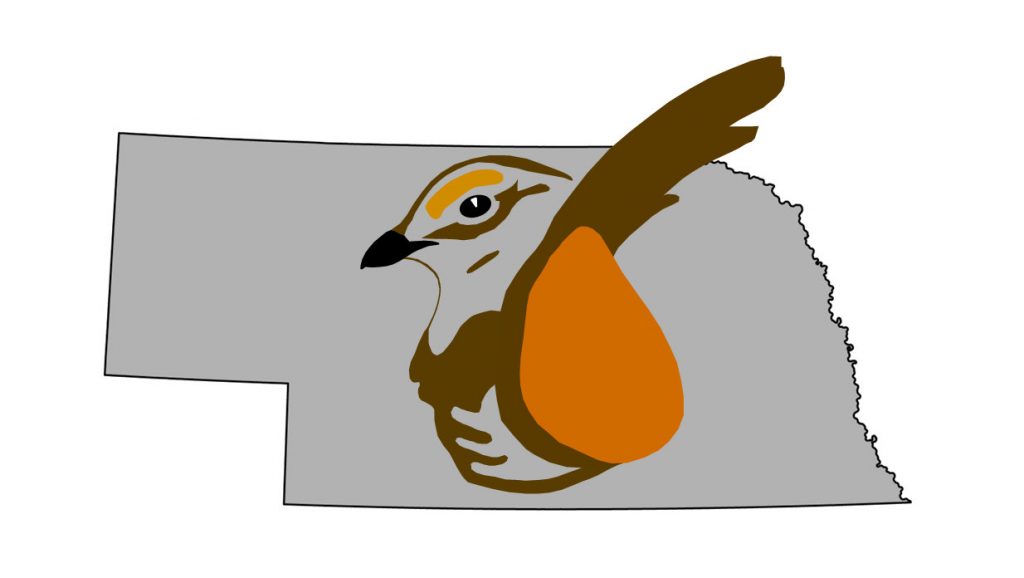Scolopax minor
Status: Uncommon regular spring and fall migrant east, rare central, rare casual west. Uncommon regular breeder east, rare central. Uncommon post-breeding summer resident northeast and north, rare elsewhere.
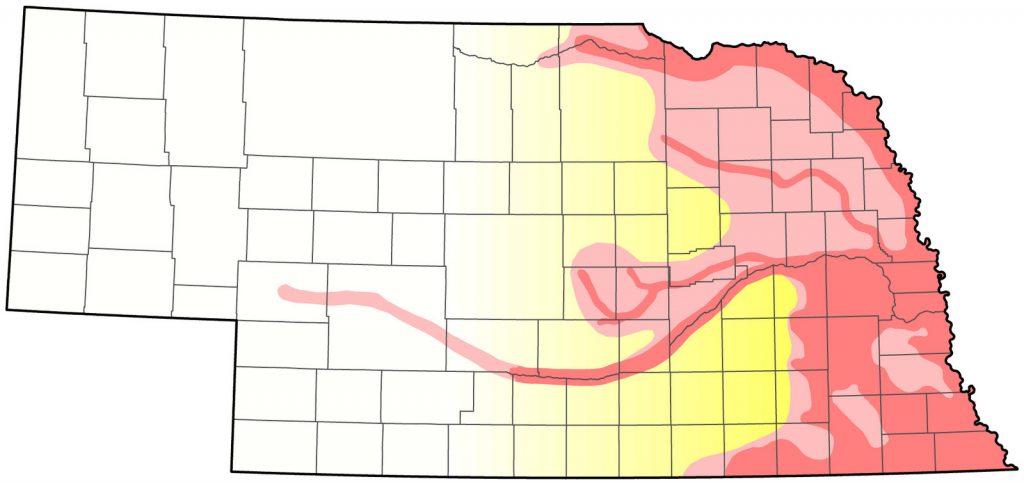
Documentation: Specimen: UNSM ZM6132, 19 Apr 1900 Lincoln, Lancaster Co.
Taxonomy: No subspecies are recognized.
Spring: Feb 25, 26, 27 <<<>>> summer
Earlier dates are 12 Feb 2024 Two Rivers SRA, Douglas Co, 21 Feb 2017 Douglas Co, and 22 Feb 2024 Walnut Creek RA, Sarpy Co.
Arrivals in 2024 were quite early, the four earliest comprising four of the six earliest on record: one heard at Two Rivers SRA, Douglas Co 12 Feb and two recorded there 13 Feb, two recorded at Walnut Creek RA, Sarpy Co 22 Feb, four heard at Wood Duck WMA, Stanton Co 25 Feb, and four recorded at Cunningham Lake, Douglas Co 26 Feb.
Woodcocks arrive by early to mid-Mar and peak abundance occurs during the latter half of that month. Males begin performing courtship display shortly after arrival. Migration and breeding or attempted breeding appear to overlap in early spring. A majority of woodcock arriving and engaging in courtship behaviors and breeding in early spring continue migrating to northern portions of the species breeding range (e.g, Minnesota, Manitoba, and Quebec) by early to mid-Apr based on a satellite telemetry study (Brenner and Jorgensen 2023a). Thus, overall abundance in Nebraska decreases markedly by mid- to late April (Jorgensen and Brenner 2023a).
Prior to European settlement, woodcocks were restricted to the Missouri River and lower portions of major tributaries (Bruner et al 1904; Lingle 1981). Although it has been assumed the species expanded its range slowly westward during the 20th Century (Sharpe et al 2001), woodcock were, in fact, rarely reported anywhere in the state until the late 1970s (Jorgensen and Brenner 2023). Swenk (1934) noted following sightings of a woodcock in Lincoln, Lancaster Co, 17-21 May 1934 that the species had been reported in Nebraska “only four or five times during the past thirty years.” Lingle (1981) conducted an extensive review and tallied only 15 reports from 1930-1969 and locating no reports during the 1950s. It was not until the 1980s that woodcock were reported regularly from multiple counties. It is not clear if woodcock were overlooked or they rapidly expanded their range, or both, during this period, but since the late 1980s and early 1990s woodcock have become widespread albeit somewhat localized in the eastern half or so of Nebraska.
Woodcock distribution generally follows river systems from east to west, with higher densities in the east and reports becoming scattered and localized and ultimately the species is absent over most of central and western Nebraska. This species may be quite rare in Republican River valley in the south-central where there is only one recent report, 18 Mar 2010 Webster Co. Roadside surveys specifically focused on this species in that system in Mar and May 2020 did not detect displaying males in Webster, Harlan, or Franklin Cos (NGPC, unpublished data).
In the Niobrara River Valley system, woodcock may be restricted primarily to lower areas, primarily Knox Co. However, one was heard and seen at Valentine, Cherry Co 16 May 2015, one was flushed at Fort Niobrara NWR, Cherry Co 22 Jun 2006, and one was reported “peenting” at close range there 10 Jul 2021.
In the Elkhorn River drainage, the species has been regularly observed about as far west as in the Niobrara River Valley. Two displaying males were observed at Dry Creek WMA 2 Apr 2022 (J. Kounovsky, personal communication) and one was seen near Page, Holt Co in early May 2003. Woodcock have been observed multiple years at Grove Lake WMA, Antelope Co, most recently in 2022 (J. Kounovsky, personal communication).
In the Loup Drainage, one was near the base of the dam at Calamus Reservoir in Garfield Co Jun 2000, but there were no further records until 2018, when three displaying birds were in Loup Co at Gracie Creek 5 Apr, and in 2019, singles were Nunda Shoal 5 Apr and Hannaman Bayou 19 Apr, and 2-4 were at Gracie Creek 24-27 Mar. Four were displaying near the southwest edge of the reservoir in Garfield Co 20 Apr 2019. In 2020, breeding was confirmed when an adult and two fledglings were found below the Calamus Reservoir dam in Loup Co 6 May (Taylor Dixon, personal communication); there were reports of up to five at Gracie Creek 24-28 Mar. In 2021, reports continued at Gracie Creek with peenting heard 31 Mar and 5 Apr, and in 2022 1-2 were present 24 Mar-2 Apr. One of these tracked via satellite telemetry in 2022 remained at Calamus Reservoir through August 2022.
Westernmost birds were reported from Elm Creek, Buffalo Co, although one was seen near Sarben in southeast Keith Co 18 Jun 2002, 16 May 1936 Lincoln Co and another was heard near Paxton, Keith Co 31 Mar 2009, the westernmost to date in the Platte River Valley. It was reported from Howard-Hall Cos 27 Jun 1988 and 27 Jun 1987 and from Crane Meadows Visitors Center, Hall Co 5 May 2005.
Reports in the west are few and scattered in the central; the only Panhandle report is 22 Mar 2003 Bridgeport, Morrill Co, and there are two reports without date in Lincoln Co (Tout 1936), as well as reports of single birds 23 Mar 2007 at Goose Lake, near Chambers, Cherry Co, 27 Mar 2007 Lincoln Co, one heard near Bassett, Rock Co 2 Apr 2005, Central Platte River Valley reports are 12 Mar 1975 Clay Co (Cortelyou 1975), one photographed 12 Mar 2011 at Hastings, Adams Co, 13 Mar 2007 near Dannebrog, Howard Co, 22 Mar 2011 near Gibbon, Buffalo Co, and 26 Mar 1988 Polk Co.
This species is difficult to detect. The true extent of the breeding range is not well known and range limits in the Platte, Niobrara, Loup, and Elkhorn River valleys require further clarification.
- High counts: 15 at Branched Oak Lake, Lancaster Co 25 Mar 1997, 8 at Boyer Chute NWR, Washington Co 15 Mar 2011, and 7 at Walnut Creek RA, Sarpy Co 16 Mar 2022.
Summer: Woodcock spring migration and courtship overlap extensively in early spring (Mar-Apr) and the number of woodcocks, as well as the spatial distribution of birds, changes once migration concludes and following nest initiation. Males performing courtship displays may not necessarily represent actual breeding in some areas. However, breeding may occur just about anywhere in the eastern two thirds of Nebraska, but abundance appears higher in the northeast based on total number of reports as well as data from satellite telemetered birds (Brenner and Jorgensen 2023a). Overall numbers of woodcock decrease by late spring and early summer (Jorgensen and Brenner 2023a). All eight woodcock trapped and outfitted with satellite tags in Lancaster Co 2021-2022 migrated to Manitoba, Ontario or Minnesota by early May (Brenner and Jorgensen 2023a).
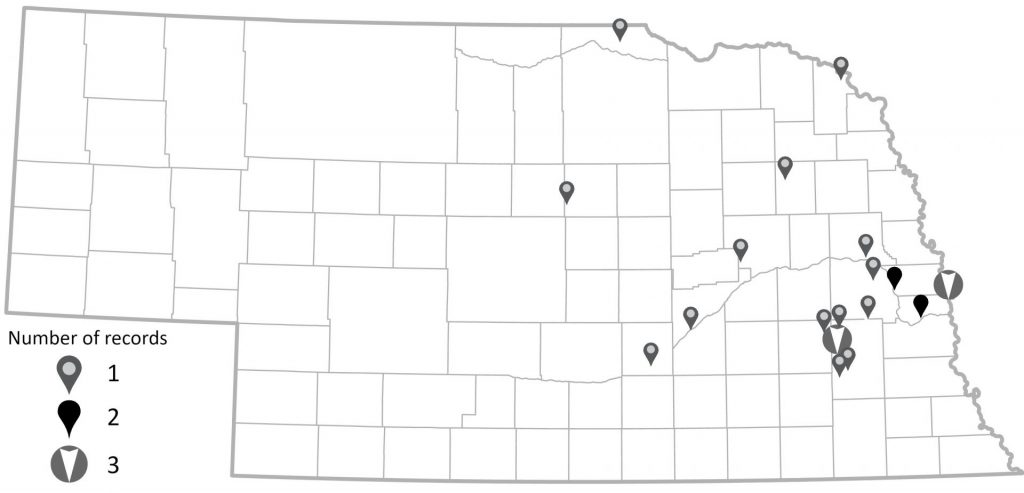
Only 24 definitive breeding records are known from Nebraska (Jorgensen and Brenner 2023a; Figure 1). All were from the eastern half of Nebraska, none south of Lancaster County and farthest west are records from Hall, Garfield and Boyd Cos. Nest initiation appears to take place primarily in the latter half of March and the first half of April (Jorgensen and Brenner 2023a).
Breeding Phenology
Eggs: 20 Mar- 3 May (Mollhoff 2022; Jorgensen and Brenner 2023a)
Flightless chicks: 23 Apr – 4 Jun (Jorgensen and Brenner 2023a)
Because woodcock breed early in spring and also because males do not participate in nesting or brood-rearing, the traditional summer (Jun-Jul) may largely represent a period of post-breeding activities and movements. Four woodcocks tracked by satellite transmitters 2021-2022 that remained in Nebraska from May-Aug all made short distance movements and also extensively used irrigated agricultural fields (Brenner and Jorgensen 2023b). A woodcock observed in Lincoln, Lancaster Co yard 24 Jul 2005 was likely a post-breeder making short distance movements rather than an actual migrant.
Fall: summer <<<>>> Nov 12, 14, 18
The few reports are scattered throughout the period, but peak migration appears to occur during late Oct through mid Nov. Birds summering in Nebraska tracked with satellite telemetry initiated autumn migration from 31 Oct through 21 Nov, whereas birds summering north of the state typically initiated fall movements much earlier (Brenner and Jorgensen 2023a). There is a later report 8 Dec 1994 Otoe Co, which consisted of a woodcock emerging from a Wood Duck nest box near a warm water spring during a spell of sub-zero weather (Bergman and Bergman 1995). An indication of ongoing migration was the downing during a winter storm of several woodcocks into back yards 24-26 Oct 2020 when at least eight such birds were reported; this phenomenon as it occurred in Kansas was discussed in detail by Janzen et al (2022).
Westerly reports are limited to a report of three birds 23 Oct 1928 in Lincoln Co (Tout 1947), one shot by a hunter in the Chase/Perkins Cos area 31 Oct 2020, one at Medicine Creek WMA, Frontier Co 10 Nov 2023, one at Crescent Lake NWR headquarters, Garden Co 6 Nov 1999 (Jorgensen 2001), one photographed at Gordon, Sheridan Co 14 Nov 2012, and one at Ash Hollow SHP, Garden Co 27 Dec 2021, the latter three the only Panhandle records. Andrews and Righter (1992) list five records for the eastern Colorado plains in the period 5 Jul-30 Nov, and eBird (accessed Dec 2023) has five subsequent records, three in Nov, one in Feb, and one Apr-May.
Images
Abbreviations
NGPC: Nebraska Game and Parks Commission
NWR: National Wildlife Refuge
RA: Recreation Area
SHP: State Historical Park
UNSM: University of Nebraska State Museum
WMA: Wildlife Management Area (State)
Literature Cited
Andrews, R., and R. Righter. 1992. Colorado birds. Denver Museum of Natural History, Denver, Colorado, USA.
Bergmann, D.L., and J.M. Bergmann. 1995. American Woodcock use of a nest box. Prairie Naturalist 27: 172-173.
Brenner, S.J., and J.G. Jorgensen. 2023a. The outsiders: American Woodcock movements and migratory patterns in the Great Plains of North America. Wader Study 130: 1-9. 10.18194/ws.00309
Brenner, S.J., and J.G. Jorgensen. 2023b. Industrial agricultural and woody encroachment associated with American Woodcock habitat selection in an altered grassland ecosystem. Canadian Journal of Zoology e-first. https://doi.org/10.1139/cjz-2023-0123
Bruner, L., R.H. Wolcott, and M.H. Swenk. 1904. A preliminary review of the birds of Nebraska, with synopses. Klopp and Bartlett, Omaha, Nebraska, USA.
Cortelyou, R.G. 1975. 1975 (Fiftieth) Spring Migration and Occurrence Report. NBR 43: 46-66.
Janzen, P., C. Otte, and M. Umscheid. 2022. Weather-related observations of American Woodcock (Scolopax minor) in Kansas during late October 2020. Kansas Ornithological Society Bulletin 73: 33-42.
Jorgensen, J.G. and S.J. Brenner. 2023. Rethinking the status and temporal occurrence of the American Woodcock in Nebraska because of its unusual life history. Nebraska Bird Review 91: 71-83.
Lingle, G.R. 1981. Status of the American Woodcock in Nebraska with notes on a breeding record. Prairie Naturalist 13:47-51.
Mollhoff, W.J. 2022. Nest records of Nebraska birds. Nebraska Ornithologists’ Union Occasional Paper Number 9.
Silcock, W.R., and R.C. Rosche. 1994. Spring Field Report, March-May 1994. NBR 62: 66-88.
Swenk, M.H. 1934. Occurrence of the American Woodcock within the city of Lincoln. Nebraska Bird Review 2: 63-65.
Tout, W. 1936. The Birdlife of Lincoln County. NBR 4: 51-52.
Tout, W. 1947. Lincoln County birds. Published by the author, North Platte, Nebraska, USA.
Recommended Citation
Silcock, W.R., and J.G. Jorgensen. 2024. American Woodcock (Scolopax minor). In Birds of Nebraska — Online. www.BirdsofNebraska.org
Birds of Nebraska – Online
Updated 4 Jun 2024; map updated 1 Jan 2024
